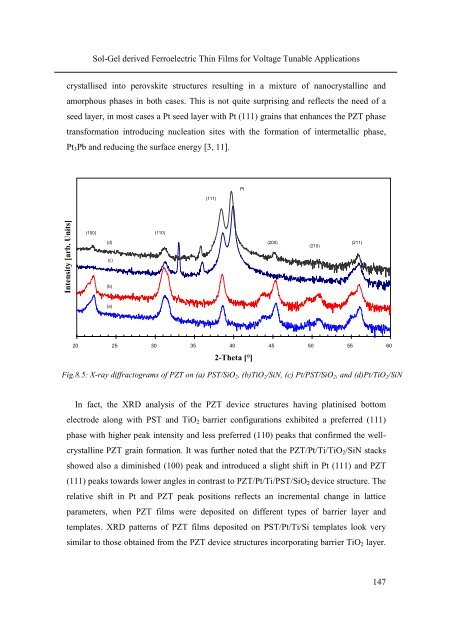PhD Thesis Arne Lüker final version V4 - Cranfield University
PhD Thesis Arne Lüker final version V4 - Cranfield University
PhD Thesis Arne Lüker final version V4 - Cranfield University
You also want an ePaper? Increase the reach of your titles
YUMPU automatically turns print PDFs into web optimized ePapers that Google loves.
Intensity [arb. Units]<br />
Sol-Gel derived Ferroelectric Thin Films for Voltage Tunable Applications<br />
crystallised into perovskite structures resulting in a mixture of nanocrystalline and<br />
amorphous phases in both cases. This is not quite surprising and reflects the need of a<br />
seed layer, in most cases a Pt seed layer with Pt (111) grains that enhances the PZT phase<br />
transformation introducing nucleation sites with the formation of intermetallic phase,<br />
Pt3Pb and reducing the surface energy [3, 11].<br />
(100) (110)<br />
(d)<br />
(c)<br />
(b)<br />
(a)<br />
(111)<br />
(200) (210) (211)<br />
20 25 30 35 40 45 50 55 60<br />
In fact, the XRD analysis of the PZT device structures having platinised bottom<br />
electrode along with PST and TiO2 barrier configurations exhibited a preferred (111)<br />
phase with higher peak intensity and less preferred (110) peaks that confirmed the well-<br />
crystalline PZT grain formation. It was further noted that the PZT/Pt/Ti/TiO2/SiN stacks<br />
showed also a diminished (100) peak and introduced a slight shift in Pt (111) and PZT<br />
(111) peaks towards lower angles in contrast to PZT/Pt/Ti/PST/SiO2 device structure. The<br />
relative shift in Pt and PZT peak positions reflects an incremental change in lattice<br />
parameters, when PZT films were deposited on different types of barrier layer and<br />
templates. XRD patterns of PZT films deposited on PST/Pt/Ti/Si templates look very<br />
similar to those obtained from the PZT device structures incorporating barrier TiO2 layer.<br />
Pt<br />
2-Theta [°]<br />
Fig.8.5: X-ray diffractograms of PZT on (a) PST/SiO2, (b)TiO2/SiN, (c) Pt/PST/SiO2, and (d)Pt/TiO2/SiN<br />
147

















